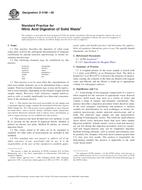We need your consent to use the individual data so that you can see information about your interests, among other things. Click "OK" to give your consent.
ASTM D5198-09
Standard Practice for Nitric Acid Digestion of Solid Waste
STANDARD published on 1.2.2009
The information about the standard:
Designation standards: ASTM D5198-09
Note: WITHDRAWN
Publication date standards: 1.2.2009
SKU: NS-30238
The number of pages: 4
Approximate weight : 12 g (0.03 lbs)
Country: American technical standard
Category: Technical standards ASTM
The category - similar standards:
Annotation of standard text ASTM D5198-09 :
Keywords:
digestion, nitric acid, waste, Lead screening testing, Manganese, Nickel, Zinc, Nitric acid, Oily sludges, Phosphorus, Sludge, Toxicity/toxicology, Vanadium, Waste materials/processing/analysis, Aluminum, Beryllium, Cadmium metals/alloys, Chromium, Copper, Digestion, Inorganic compounds, Iron, ICS Number Code 13.030.10 (Solid wastes)
Additional information
| Significance and Use | |||||||||||||||||||||
|
A knowledge of the inorganic composition of a waste is often required for the selection of appropriate waste disposal practices. Solid waste may exist in a variety of forms and contain a range of organic and inorganic constituents. This practice describes a digestion procedure which dissolves many of the toxic inorganic constituents and produces a solution suitable for determination by such techniques as atomic absorption spectroscopy, atomic emission spectroscopy, and so forth. The relatively large sample size aids representative sampling of heterogenous wastes. The relatively small dilution factor allows lower detection limits than most other sample digestion methods. Volatile metals, such as lead and mercury, are not lost during this digestion procedure, however organo-lead and organo-mercury may not be completely digested. Hydride-forming elements, such as arsenic and selenium, may be partially lost. Samples with total metal contents greater than 5 % may give low results. The analyst is responsible for determining whether this practice is applicable to the solid waste being tested. |
|||||||||||||||||||||
| 1. Scope | |||||||||||||||||||||
|
1.1 This practice describes the digestion of solid waste using nitric acid for the subsequent determination of inorganic constituents by plasma emission spectroscopy or atomic absorption spectroscopy. 1.2 The following elements may be
solubilized by this practice:
1.3 This practice is to be used when the concentrations of total recoverable elements are to be determined from a waste sample. Total recoverable elements may or may not be equivalent to total elements, depending on the element sought and the sample matrix. Recovery from refractory sample matrices, such as soils, is usually significantly less than total concentrations of the elements present. Note 1—This practice has been used successfully for oily sludges and a municipal digested sludge standard [Environmental Protection Agency (EPA) Sample No. 397]. The practice may be applicable to some elements not listed above, such as arsenic, barium, selenium, cobalt, magnesium, and calcium. Refractory elements such as silicon, silver, and titanium, as well as organo-mercury are not solubilized by this practice. 1.4 This practice has been divided into two methods, A and B, to account for the advent of digestion blocks. Method A utilizes an electric hot plate; Method B utilizes an electric digestion block. 1.5 The values stated in SI units are to be regarded as standard. No other units of measurement are included in this standard. 1.6 This standard does not purport to address all of the safety concerns, if any, associated with its use. It is the responsibility of the user of this standard to establish appropriate safety and health practices and determine the applicability of regulatory limitations prior to use. For specific hazard statements, see Section 7. |
|||||||||||||||||||||
| 2. Referenced Documents | |||||||||||||||||||||
|
We recommend:
Technical standards updating
Do you want to make sure you use only the valid technical standards?
We can offer you a solution which will provide you a monthly overview concerning the updating of standards which you use.
Would you like to know more? Look at this page.




 Cookies
Cookies
